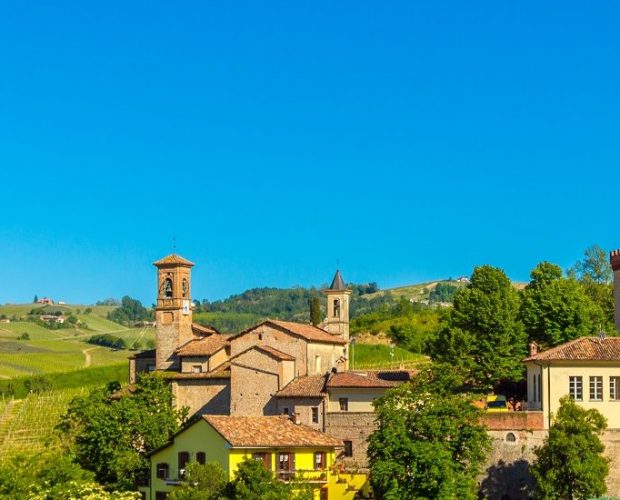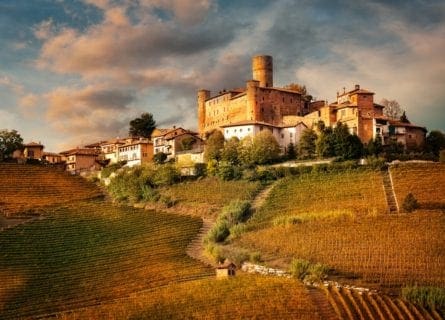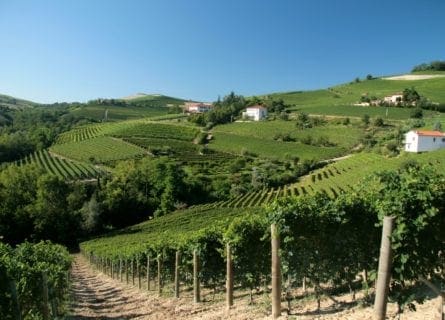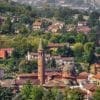Visit Barolo: A medieval gem in Italy's Langhe, famed for its 'King of Wines' Nebbiolo, historic castle, and enchanting vineyard tours.
Read more
EXPLORE ALL OUR PIEDMONT WINE REGION GUIDE
Last updated: February 25, 2024
If Barbaresco is an excellent example of Nebbiolo, Barolo is the greatest expression of this singular grape. Like Burgundy, it is a region that continues to ignite passion, fetch impressive prices, and lubricate the cogs of the fine wine trade. The formula involves calcareous clay soils on the right bank of the River Tanaro in Northwest Italy, which, combined with a unique climate and unparalleled expertise, grows Nebbiolo to perfection. In the best years, the results are pure bottled magic: autumnal aromas wrapped around red fruit, leather, spice, wax, and incense. The tannins, often harsh in their youth, melt into velvety elegance. In every sense, Piedmont is Italy’s answer to the Cote d’Or – a paradise for collectors and connoisseurs.

Nebbiolo has been cultivated in the undulating landscape of Piedmont for centuries; it is said that the poet and philosopher Pliny the Elder once sang its praises as one of the great wines of northwestern Italy. Others believe the variety can trace its lineage back to the ancient wines of Georgia – none of this can be proved categorically. Nevertheless, viticulture thrived during the Roman period while successive emperors drove their armies into northern Europe and the Maghreb. At the height of its power, millions of people from diverse cultures swore allegiance to the might of Rome.
However, this grandiose political project began to disintegrate in the early 5th century, reaching a low point during Alaric’s sacking of Rome in AD 410. Meanwhile, the latter part of the century witnessed utter chaos as the Goths, Lombards, and Franks all attempted to conquer the Italian Peninsula. But the Germanic Lombards emerged triumphant, taking control of the peninsula in 568. Relative peace and stability reigned in northern and central Italy for over two hundred years, particularly under the wise rule of King Liutprand. Yet a great deal of animosity existed between the Lombards and the Catholic Church; this greatly contributed to their downfall in the 8th century, as the Franks were paid blood money to eject the Lombards from northern Italy. After their swift and successful campaign led by Charlemagne, the kingdom of Lombardy was absorbed into the Frankish Empire.
In the 16th century, the Duke of Savoy Emmanuel Philibert conquered various territories in France and Spain, including the city of Turin. The duchy prospered for the next two hundred years, annexing the island of Sardinia in 1720. However, Napoleon invaded the city at the end of the century and was finally defeated by the combined forces of Britain, Prussia, Russia, and Spain. Austria and Russia controlled Turin before the great patriot Vittorio Emanuele I restored the House of Savoy and reclaimed Turin in 1814.
During this period, Barolo developed into the exceptional dry red we know and love today. Before the mid-1800s, Nebbiolo was produced as a sweet wine in Piedmont, a state of affairs that Camillo Benso, Conte di Cavour, found unsatisfactory. After a failed experiment with five hectares of Pinot Noir, he invited the oenologist Louis Oudart to Piedmont, hoping he could transform Barolo’s ailing reputation. Oudart succeeded in his mission, revolutionizing viticulture and winemaking in the zone. Turin’s elite enthusiastically welcomed this new interpretation of Barolo, giving rise to the legendary moniker “Barolo the wine of kings, the king of wines.” The region was awarded DOCG status in 1980.

Barolo is the jewel in Piedmont’s crown and a beguiling destination for the wine connoisseur. The appellation is situated in Northwest Italy, just to the southwest of the small city of Alba. The landscape is utterly gorgeous: the undulating expanse of the Langhe hills is punctuated by two tributaries of the Tanaro River – Talloria dell’Annunziata and the Talloria di Castiglione. These streams split Barolo into three key subregions, with a multitude of differences in soil, aspect, and altitude, creating a patchwork of distinct terroirs.
This is a key reason why critics are drawn to Barolo; remarkable differences in local growing conditions generate endless fascination and debate. The vines are spread across 11 communes (including the hamlet of Barolo) in the Langhe hills, which cover endless altitude variations, exposition, and mesoclimates. Barolo is a veritable paradise for any wine enthusiast determined to uncover the secrets of the soil. For example, vineyards planted in the circle surrounding La Morra benefit from calcareous soils similar to Barbaresco’s; this terroir produces some of the best wines in the region, with good color and structure and always abundant tannins.
Yet the western hills of the zone in Barolo and La Morra’s areas tend to give less tense, more aromatically expressive wines that require less bottle age. Some of the most famous climats in Barolo include Brunate, Le Rocche, La Serra, and Cannubi; the last cru was the subject of a fierce legal battle some years ago.
Moving further east, we encounter a very different set of growing conditions. The vineyards of Castiglione Falleto and Serralunga d’Alba are planted on less fertile soils, often containing a layer of sandstone in the topsoil. This means warmer soils, higher ripeness levels – particularly in hot years – and more concentrated wines. But these differences continue within the sub-zone: the wines of Castiglione and Falleto tend to be softer than those of Serralunga. Equally, the valleys surrounding Barolo and Serralunga are conducive to noticeable differences in wine style.
Meanwhile, Bricco Rocche, with its sandy soils, usually gives perfumed wines with more finesse than the inferior examples of Barolo. Like Pinot Noir, Nebbiolo is adept at transmitting terroir and providing the drinker with a signposted description of its origins. In a sense, there is no such thing as Barolo pure and straightforward, as this is arguably the least homogeneous vineyard in Italy.
Barolo was once the world’s most uncompromising wine, requiring decades of bottle age before those tannins softened and the ethereal aromas could emerge from the glass. The results were harsh, tannic, and forgettable in weaker years and from poor growers. It is always a 100%-Nebbiolo wine; the appellation rules state that blending is illegal unless declassified. Moreover, wines labeled as Barolo must be aged for at least 38 months before their commercial release. This includes 18 months in oak and 20 months in bottle. Wines labeled ‘Riservas’ are often aged for longer than the minimum of 62 months.
Historically, most growers harvested as late as possible in the season to allow the build-up of sugar, tannin, and coloring pigments. The berries were then typically fermented in old oak vats; the lack of temperature control could lead to a loss of primary fruit flavor, exacerbated by an extended maceration – up to one month in some instances. Traditional producers would mature their wines in old Slovenian oak and chestnut for several years, as adding wood tannins was considered undesirable. This extended aging period would help to mellow high tannin levels, although far too many Barolos never shed their austerity.
Nonetheless, the traditionalists continue to make Barolo in this uncompromising way, confident that their customers have patience and good taste. At their best, such wines will age into glorious complexity and improve in bottle for many decades, showcasing significant nuances and tertiary flavors. At their worst, they are unpleasant mouthfuls of tart dross. Bruno Giacosa and Aldo Conterno are unashamed classicists with no paucity of aficionados in the secondary market.
But other producers are changing with the times. Modern techniques have found a welcome home in some Barolo cellars, emphasizing temperature-controlled fermentation in stainless steel, aging in new French oak for shorter periods, and picking late into the season. Global warming, however, may discourage that practice from becoming widespread. These wines are equally splendid and can be approached earlier – a definite advantage if you pitch to Millennial consumers.
It is often said that Barolo is Burgundy’s Italian sibling. Yet, unlike their Gallic counterparts, the Piemontese have never settled the terroir ranking in Barolo despite significant variations in soil, aspect, and vineyard elevation. Meanwhile, arguments concerning tradition versus modernity continue to rage in this venerable and complex region. Producers from both camps are convinced of the correctness of their chosen winemaking philosophy. Thus, one of Italy’s biggest export success stories remains a hotbed of volatile emotions.
The subject of terroir classification is fundamental to the schisms lurking in Barolo’s cellars. Historically, major producers were very reticent about codifying a hierarchy of their various terroirs despite widespread agreement about their relative merits and individual characteristics. Unlike the Cote d’Or, Barolo was always a blend of fruit from different terroirs across the region, bought by merchants whose name came first rather than that of a single site. Before the 21st century, no legally approved list of vineyard names or cru existed.
However, in 2008, a landmark move was made by the Consortium of Barolo and Barbaresco growers, who began to construct a list of sub-zones and cru – after many years of lobbying from influential figures in the industry. Their recognition of the vineyards and sub-areas was primarily based on the work of renowned winemaker Renato Ratti, who, in 1980, after years of painstaking research, created a map of Barolo crus. This was enshrined in the so-called ‘Menzione Act.’ Today, these often minute differences are of great interest to growers, collectors, and critics, but Barolo has fallen short of creating a hierarchical ranking. A major court case involving the Cannubi vineyard and a decision to enlarge its boundaries is still a painful memory for the region. Terroir classification, it seems, is too controversial for some; however, it is essential for others. A consensus is unlikely to be reached anytime soon.
Neither can people agree about the ‘right’ way to make Barolo. Taking an objective view, there is no doubt that modern winemaking produces a more fruity and supple expression of the Nebbiolo grape – arguably a better wine altogether. But are they better, Barolos? Do they sacrifice authenticity at the altar of instant gratification? Traditional Barolo could be as tough as old boots, yet its astounding depth and complexity are seldom replicated in the modern style. Even today, there is no shortage of collectors prepared to wait twenty years before thinking seriously about opening their wines. Could any other region ask that of its fan base? The answer, most definitely, is no.
Explore Arneis: A Fascinating Journey Through Piedmont's Wine Heritage from Ancient Romans to Modern Resurgence
Find out moreNebbiolo is an Italian red grape primarily linked to Piedmont, where it creates prestigious DOCG wines like Barolo, Barbaresco, and others. Its name may come from "nebbia" or "nebia," signifying the fog that envelops Piedmont during late October harvests. Nebbiolo wines are light in color but can be intensely tannic when young, offering scents of tar and roses. They develop a brick-orange rim with age, revealing aromas like violets, truffles, cherries, and tobacco.
Piedmont is blessed with a diverse and exciting food culture that has no equal in northern Italy. Indeed, its rich bounty of truffles, risotto, pasta, and game was seemingly designed to be enjoyed alongside the delectable Nebbiolo wines of Barolo. After all, this landmark red deserves a special gastronomic pairing: risotto with white truffle, game, venison, and beef fillet, which are all marriages made in heaven. Such delights can be enjoyed in various restaurants, including temples of Michelin gastronomy, rustic trattorias, and historic cafes.
A Gastronomic Guide to the Cuisine of Piedmont: Read more

Visit Barolo: A medieval gem in Italy's Langhe, famed for its 'King of Wines' Nebbiolo, historic castle, and enchanting vineyard tours.
Read more
Discover Alba, Piedmont's culinary jewel, famed for truffles and wines. Explore rich history and gourmet paradise in Italy's food and wine capital.
Read more
Torino: A dynamic blend of royal history, industrial innovation, and cultural vibrancy, nestled in Italy's scenic northwestern Alps.
Read moreIf you would like us to customize an exclusive luxury tour, contact us and let us know your travel plans. We offer luxury food and wine tours for private groups of a minimum two guests. In addition, all of our private, chauffeured tours are available year-round upon request.

